Spatial and Temporal Drought Characteristics in the Huanghuaihai Plain and Its Influence on Cropland Water Use Efficiency
Abstract
:1. Introduction
2. Materials and Methods
2.1. Study Area
2.2. Data Source and Processing
2.2.1. Meteorological Data
2.2.2. Remote Sensing Data
2.2.3. Other Data
2.3. Research Methods
2.3.1. Data Preparation
2.3.2. Integrated Drought Index Model
2.4. Run Theory and Drought Characteristics
2.5. Time-Lag Effects of Drought on the CWUE
2.6. Theil–Sen Median and Mann-Kendall Trend Test
3. Results
3.1. Drought Index Model Accuracy and Validation
3.2. Drought Events and Characteristics Analysis in the HHHP
3.2.1. Run Theory Identifies Drought Events
3.2.2. Accuracy of Drought Event
3.2.3. Spatial Analysis of Drought Disaster in the HHHP
3.3. Correlation Analysis of the CWUE on Drought Events
4. Discussion
5. Conclusions
- The mISDI dataset in the HHHP was established, and the June data were taken as an example to establish a drought index model suitable for the HHHP. SPI03, SOSA, VSWI, AWC, DEM, LON, LAT, and YEAR were selected as independent variables, and scPDSI was a dependent variable.
- Five drought events were identified using the run theory. The first drought event had the highest intensity (−1.925) and the longest drought duration (18 months) and was considered as the most severe of all the drought events. However, the gradual decline in the mISDI over the 2001–2020 period indicated a trend of worsening drought conditions in most areas of Shandong Province and in the northeastern part of Henan Province. The recent short-term droughts alternating with wet periods was consistent with an increase in climate variability related to climate change. Further studies are needed to determine if the rapid alternation between droughts and wet periods will continue. Drought had an enhanced effect on the CWUE of the HHHP, and the enhancement of the CWUE in the eastern hilly area was more significant.
- Using the most severe drought event during the study period as an example, the correlation between drought and the CWUE was studied. The study found that there was a three-month lag period and a significant positive correlation between the response to drought and the CWUE, which was related to the irrigation habits of the HHHP. The areas with significant correlations were dominated by plains with the flattest terrain in the entire area.
Author Contributions
Funding
Data Availability Statement
Conflicts of Interest
References
- Aghakouchak, A.; Cheng, L.Y.; Mazdiyasni, O.; Farahmand, A. Global warming and changes in risk of concurrent climate extremes: Insights from the 2014 California drought. Geophys. Res. Lett. 2014, 41, 8847–8852. [Google Scholar] [CrossRef] [Green Version]
- Lesk, C.; Rowhani, P.; Ramankutty, N. Influence of extreme weather disasters on global crop production. Nature 2016, 529, 84–87. [Google Scholar] [CrossRef] [PubMed]
- Zhang, M.M.; Luo, D.; Su, Y.Q. Drought monitoring and agricultural drought loss risk assessment based on multisource information fusion. Nat. Hazards 2022, 111, 775–801. [Google Scholar] [CrossRef]
- Ito, A.; Inatomi, M. Water-use efficiency of the terrestrial biosphere: A model analysis focusing on interactions between the global carbon and water cycles. J. Hydrometeorol. 2012, 13, 681–694. [Google Scholar] [CrossRef]
- Aguilos, M.; Stahl, C.; Burban, B.; Hérault, B.; Courtois, E.; Coste, S.; Wagner, F.; Ziegler, C.; Takagi, K.; Bonal, D. Interannual and seasonal variations in ecosystem transpiration and water use efficiency in a tropical rainforest. Forests 2018, 10, 14. [Google Scholar] [CrossRef] [Green Version]
- Liu, Y.B.; Xiao, J.F.; Ju, W.M.; Zhou, Y.L.; Wang, S.Q.; Wu, X.C. Water use efficiency of China’s terrestrial ecosystems and responses to drought. Sci. Rep. 2015, 5, 13799. [Google Scholar] [CrossRef]
- Huang, L.; He, B.; Han, L.; Liu, J.J.; Wang, H.Y.; Chen, Z.Y. A global examination of the response of ecosystem water-use efficiency to drought based on MODIS data. Sci. Total Environ. 2017, 601, 1097–1107. [Google Scholar] [CrossRef]
- Sinclair, T.R.; Tanner, C.; Bennett, J. Water-use efficiency in crop production. Bioscience 1984, 34, 36–40. [Google Scholar] [CrossRef]
- Xue, B.L.; Guo, Q.H.; Otto, A.; Xiao, J.F.; Tao, S.L.; Li, L. Global patterns, trends, and drivers of water use efficiency from 2000 to 2013. Ecosphere 2015, 6, 1–18. [Google Scholar] [CrossRef]
- Xiao, J.F.; Sun, G.; Chen, J.Q.; Chen, H.; Chen, S.P.; Dong, G.; Gao, S.H.; Guo, H.Q.; Guo, J.X.; Han, S.J. Carbon fluxes, evapotranspiration, and water use efficiency of terrestrial ecosystems in China. Agric. For. Meteorol. 2013, 182, 76–90. [Google Scholar] [CrossRef]
- Tian, H.Q.; Chen, G.S.; Liu, M.L.; Zhang, C.; Sun, G.; Lu, C.Q.; Xu, X.F.; Ren, W.; Pan, S.F.; Chappelka, A. Model estimates of net primary productivity, evapotranspiration, and water use efficiency in the terrestrial ecosystems of the southern United States during 1895–2007. For. Ecol. Manag. 2010, 259, 1311–1327. [Google Scholar] [CrossRef]
- Gang, C.C.; Wang, Z.Q.; Chen, Y.Z.; Yang, Y.; Li, J.L.; Cheng, J.M.; Qi, J.G.; Odeh, I. Drought-induced dynamics of carbon and water use efficiency of global grasslands from 2000 to 2011. Ecol. Indic. 2016, 67, 788–797. [Google Scholar] [CrossRef]
- Tong, X.J.; Mu, Y.M.; Zhang, J.S.; Meng, P.; Li, J. Water stress controls on carbon flux and water use efficiency in a warm-temperate mixed plantation. J. Hydrol. 2019, 571, 669–678. [Google Scholar] [CrossRef]
- Piao, S.L.; Ciais, P.; Huang, Y.; Shen, Z.H.; Peng, S.S.; Li, J.S.; Zhou, L.P.; Liu, H.Y.; Ma, Y.C.; Ding, Y.H. The impacts of climate change on water resources and agriculture in China. Nature 2010, 467, 43–51. [Google Scholar] [CrossRef]
- Xu, J.W.; Ju, H.; Mei, X.R.; Liu, Q.; Yang, J.Y. Simulation on potential effects of drought on winter wheat in Huang-Huai-Hai Plain from 1981 to 2010. Trans. Chin. Soc. Agric. Eng. 2015, 31, 150–158. [Google Scholar]
- Xue, C.Y.; Ma, Z.H.; Hu, C.D. Spatiotemporal characteristics of drought during summer maize growing season in Huang-Huai-Hai area for recent 40 years. J. Nat. Disaster 2016, 25, 1–14. [Google Scholar]
- Li, Z.; Liu, S.; Sun, R.; Liu, W. Identifying the temporal-spatial pattern evolution of the multiple cropping index in the Huang-Huai-Hai region. Acta Ecol. Sin. 2018, 38, 4454–4460. [Google Scholar]
- Trenberth, K.E.; Dai, A.; Van Der Schrier, G.; Jones, P.D.; Barichivich, J.; Briffa, K.R.; Sheffield, J. Global warming and changes in drought. Nat. Clim. Change 2014, 4, 17–22. [Google Scholar] [CrossRef]
- Meng, L.K.; Dong, T.; Zhang, W. Drought monitoring using an Integrated Drought Condition Index (IDCI) derived from multi-sensor remote sensing data. Nat. Hazards 2016, 80, 1135–1152. [Google Scholar] [CrossRef]
- Brown, J.F.; Wardlow, B.D.; Tadesse, T.; Hayes, M.J.; Reed, B.C. The Vegetation Drought Response Index (VegDRI): A New Integrated Approach for Monitoring Drought Stress in Vegetation. GIScience Remote Sens. 2008, 45, 16–46. [Google Scholar] [CrossRef]
- Zhou, L.; Wu, J.J.; Zhang, J.H.; Leng, S.; Liu, M.; Zhang, J.; Zhao, L.; Zhang, F.Y.; Shi, Y. The integrated surface drought index (ISDI) as an indicator for agricultural drought monitoring: Theory, validation, and application in Mid-Eastern China. IEEE J. Sel. Top. Appl. Earth Observ. Remote Sens. 2013, 6, 1254–1262. [Google Scholar] [CrossRef]
- Jiang, W.X.; Wang, L.C.; Zhang, M.; Yao, R.; Chen, X.X.; Gui, X.; Sun, J.; Cao, Q. Analysis of drought events and their impacts on vegetation productivity based on the integrated surface drought index in the Hanjiang River Basin, China. Atmos. Res. 2021, 254, 105536. [Google Scholar] [CrossRef]
- Zhao, J.X.; Xu, T.R.; Xiao, J.F.; Liu, S.M.; Mao, K.; Song, L.S.; Yao, Y.J.; He, X.L.; Feng, H.Z. Responses of water use efficiency to drought in southwest China. Remote Sens. 2020, 12, 199. [Google Scholar] [CrossRef] [Green Version]
- Ji, Y.D.; Li, Y.; Yao, N.; Biswas, A.; Zou, Y.F.; Meng, Q.T.; Liu, F.G. The lagged effect and impact of soil moisture drought on terrestrial ecosystem water use efficiency. Ecol. Indic. 2021, 133, 108349. [Google Scholar] [CrossRef]
- Tian, H.F.; Chen, T.; Li, Q.Z.; Mei, Q.Y.; Wang, S.; Yang, M.D.; Wang, Y.J.; Qin, Y.C. A Novel Spectral Index for Automatic Canola Mapping by Using Sentinel-2 Imagery. Remote Sens. 2022, 14, 1113. [Google Scholar] [CrossRef]
- Tian, H.F.; Qin, Y.C.; Niu, Z.; Wang, L.; Ge, S.S. Summer Maize Mapping by Compositing Time Series Sentinel-1A Imagery Based on Crop Growth Cycles. J. Indian Soc. Remote 2021, 49, 2863–2874. [Google Scholar] [CrossRef]
- Tian, H.F.; Wang, Y.J.; Chen, T.; Zhang, L.J.; Qin, Y.C. Early-Season Mapping of Winter Crops Using Sentinel-2 Optical Imagery. Remote Sens. 2021, 13, 3822. [Google Scholar] [CrossRef]
- Militino, A.F.; Ugarte, M.D.; Pérez-Goya, U.; Genton, M.G. Interpolation of the mean anomalies for cloud filling in land surface temperature and normalized difference vegetation index. IEEE Trans. Geosci. Remote Sens. 2019, 57, 6068–6078. [Google Scholar] [CrossRef]
- Wu, J.J.; Zhou, L.; Liu, M.; Zhang, J.; Leng, S.; Diao, C.Y. Establishing and assessing the Integrated Surface Drought Index (ISDI) for agricultural drought monitoring in mid-eastern China. Int. J. Appl. Earth Obs. Geoinf. 2013, 23, 397–410. [Google Scholar] [CrossRef]
- Wu, J.J.; Zhou, L.; Mo, X.Y.; Zhou, H.K.; Zhang, J.; Jia, R.J. Drought monitoring and analysis in China based on the Integrated Surface Drought Index (ISDI). Int. J. Appl. Earth Obs. Geoinf. 2015, 41, 23–33. [Google Scholar] [CrossRef]
- Vicente-Serrano, S.M.; Beguería, S.; López-Moreno, J.I. A Multiscalar Drought Index Sensitive to Global Warming: The Standardized Precipitation Evapotranspiration Index. J. Clim. 2010, 23, 1696–1718. [Google Scholar] [CrossRef] [Green Version]
- Wells, N.; Goddard, S.; Hayes, M.J. A Self-Calibrating Palmer Drought Severity Index. J. Clim. 2004, 17, 2335–2351. [Google Scholar] [CrossRef]
- Guttman, N.B. Accepting the standardized precipitation index: A calculation algorithm 1. JAWRA J. Am. Water Resour. Assoc. 1999, 35, 311–322. [Google Scholar] [CrossRef]
- Zhang, L.; Xiao, J.F.; Zhou, Y.; Zheng, Y.; Li, J.; Xiao, H. Drought events and their effects on vegetation productivity in China. Ecosphere 2016, 7, e01591. [Google Scholar] [CrossRef]
- Yevjevich, V.M. An Objective Approach to Definitions and Investigations of Continental Hydrologic Droughts. Ph.D. Thesis, Colorado State University, Libraries, Fort Collins, CO, USA, 1967. [Google Scholar]
- Guo, H.; Bao, A.; Liu, T.; Ndayisaba, F.; Jiang, L.L.; Kurban, A.; De Maeyer, P. Spatial and temporal characteristics of droughts in Central Asia during 1966–2015. Sci. Total Environ. 2018, 624, 1523–1538. [Google Scholar] [CrossRef]
- Wang, F.; Wang, Z.M.; Yang, H.B.; Zhao, Y.; Zhang, Z.Z.; Li, Z.H.; Hussain, Z. Copula-based drought analysis using Standardized Precipitation Evapotranspiration Index: A case study in the Yellow river basin, China. Water 2019, 11, 1298. [Google Scholar] [CrossRef] [Green Version]
- Wang, X.F.; Zhang, Y.; Feng, X.M.; Feng, Y.; Xue, Y.Y.; Pan, N.Q. Analysis and application of drought characteristics based on run theory and Copula function. Trans. Chin. Soc. Agric. Eng. 2017, 33, 206–214. [Google Scholar]
- Jiang, W.X.; Niu, Z.G.; Wang, L.C.; Yao, R.; Gui, X.; Xiang, F.F.; Ji, Y.X. Impacts of Drought and Climatic Factors on Vegetation Dynamics in the Yellow River Basin and Yangtze River Basin, China. Remote Sens. 2022, 14, 930. [Google Scholar] [CrossRef]
- Chu, H.S.; Venevsky, S.; Wu, C.; Wang, M.H. NDVI-based vegetation dynamics and its response to climate changes at Amur-Heilongjiang River Basin from 1982 to 2015. Sci. Total Environ. 2019, 650, 2051–2062. [Google Scholar] [CrossRef]
- Zhao, A.Z.; Yu, Q.Y.; Feng, L.L.; Zhang, A.B.; Pei, T. Evaluating the cumulative and time-lag effects of drought on grassland vegetation: A case study in the Chinese Loess Plateau. J. Environ. Manag. 2020, 261, 110214. [Google Scholar] [CrossRef]
- Hauke, J.; Kossowski, T. Comparison of values of Pearson’s and Spearman’s correlation coefficients on the same sets of data. Quaest. Geogr. 2011, 30, 87. [Google Scholar] [CrossRef] [Green Version]
- Kendall, M.G. A new measure of rank correlation. Biometrika 1938, 30, 81–93. [Google Scholar] [CrossRef]
- Jiang, W.G.; Yuan, L.H.; Wang, W.J.; Cao, R.; Zhang, Y.F.; Shen, W.M. Spatio-temporal analysis of vegetation variation in the Yellow River Basin. Ecol. Indic. 2015, 51, 117–126. [Google Scholar] [CrossRef]
- Mann, H.B. Nonparametric tests against trend. Econometrica 1945, 13, 245–259. [Google Scholar] [CrossRef]
- Zuo, D.P.; Han, Y.N.; Xu, Z.X.; Li, P.J.; Ban, C.G.; Sun, W.C.; Pang, B.; Peng, D.Z.; Kan, G.Y.; Zhang, R. Time-lag effects of climatic change and drought on vegetation dynamics in an alpine river basin of the Tibet Plateau, China. J. Hydrol. 2021, 600, 126532. [Google Scholar] [CrossRef]
- Sun, H.Y.; Liu, C.M.; Zhang, X.Y.; Shen, Y.J.; Zhang, Y.Q. Effects of irrigation on water balance, yield and WUE of winter wheat in the North China Plain. Agric. Water Manag. 2006, 85, 211–218. [Google Scholar] [CrossRef]
- Sen, P.K. Estimates of the regression coefficient based on Kendall’s tau. J. Am. Stat. Assoc. 1968, 63, 1379–1389. [Google Scholar] [CrossRef]
- Yang, S.S.; Zhang, J.H.; Han, J.Q.; Wang, J.W.; Zhang, S.; Bai, Y.; Cao, D.; Xun, L.; Zheng, M.X.; Chen, H. Evaluating global ecosystem water use efficiency response to drought based on multi-model analysis. Sci. Total Environ. 2021, 778, 146356. [Google Scholar] [CrossRef]
- Javed, T.; Zhang, J.H.; Bhattarai, N.; Sha, Z.; Rashid, S.; Yun, B.; Ahmad, S.; Henchiri, M.; Kamran, M. Drought characterization across agricultural regions of China using standardized precipitation and vegetation water supply indices. J. Clean. Prod. 2021, 313, 127866. [Google Scholar] [CrossRef]
- Gou, Q.Q.; Zhu, Y.H.; Lü, H.S.; Horton, R.; Yu, X.H.; Zhang, H.Q.; Wang, X.Y.; Su, J.B.; Liu, E.; Ding, Z.Z. Application of an improved spatio-temporal identification method of flash droughts. J. Hydrol. 2022, 604, 127224. [Google Scholar] [CrossRef]
- Wu, X.C.; Li, X.Y.; Chen, Y.H.; Bai, Y.; Tong, Y.Q.; Wang, P.; Liu, H.Y.; Wang, M.J.; Shi, F.Z.; Zhang, C.C. Atmospheric water demand dominates daily variations in water use efficiency in alpine meadows, northeastern Tibetan Plateau. J. Geophys. Res. Biogeosci. 2019, 124, 2174–2185. [Google Scholar] [CrossRef]
- Ponce-Campos, G.E.; Moran, M.S.; Huete, A.; Zhang, Y.; Bresloff, C.; Huxman, T.E.; Eamus, D.; Bosch, D.D.; Buda, A.R.; Gunter, S.A. Ecosystem resilience despite large-scale altered hydroclimatic conditions. Nature 2013, 494, 349–352. [Google Scholar] [CrossRef] [PubMed]
- El Masri, B.; Stinchcomb, G.E.; Cetin, H.; Ferguson, B.; Kim, S.L.; Xiao, J.F.; Fisher, J.B. Linking Remotely Sensed Carbon and Water Use Efficiencies with In Situ Soil Properties. Remote Sens. 2021, 13, 2593. [Google Scholar] [CrossRef]
- Zhu, X.J.; Yu, G.R.; Wang, Q.F.; Hu, Z.M.; Zheng, H.; Li, S.G.; Sun, X.M.; Zhang, Y.P.; Yan, J.H.; Wang, H.M. Spatial variability of water use efficiency in China’s terrestrial ecosystems. Glob. Planet. Change 2015, 129, 37–44. [Google Scholar] [CrossRef]
- Huang, M.T.; Piao, S.L.; Sun, Y.; Ciais, P.; Cheng, L.; Mao, J.F.; Poulter, B.; Shi, X.Y.; Zeng, Z.Z.; Wang, Y.P. Change in terrestrial ecosystem water-use efficiency over the last three decades. Glob. Change Biol. 2015, 21, 2366–2378. [Google Scholar] [CrossRef] [PubMed]
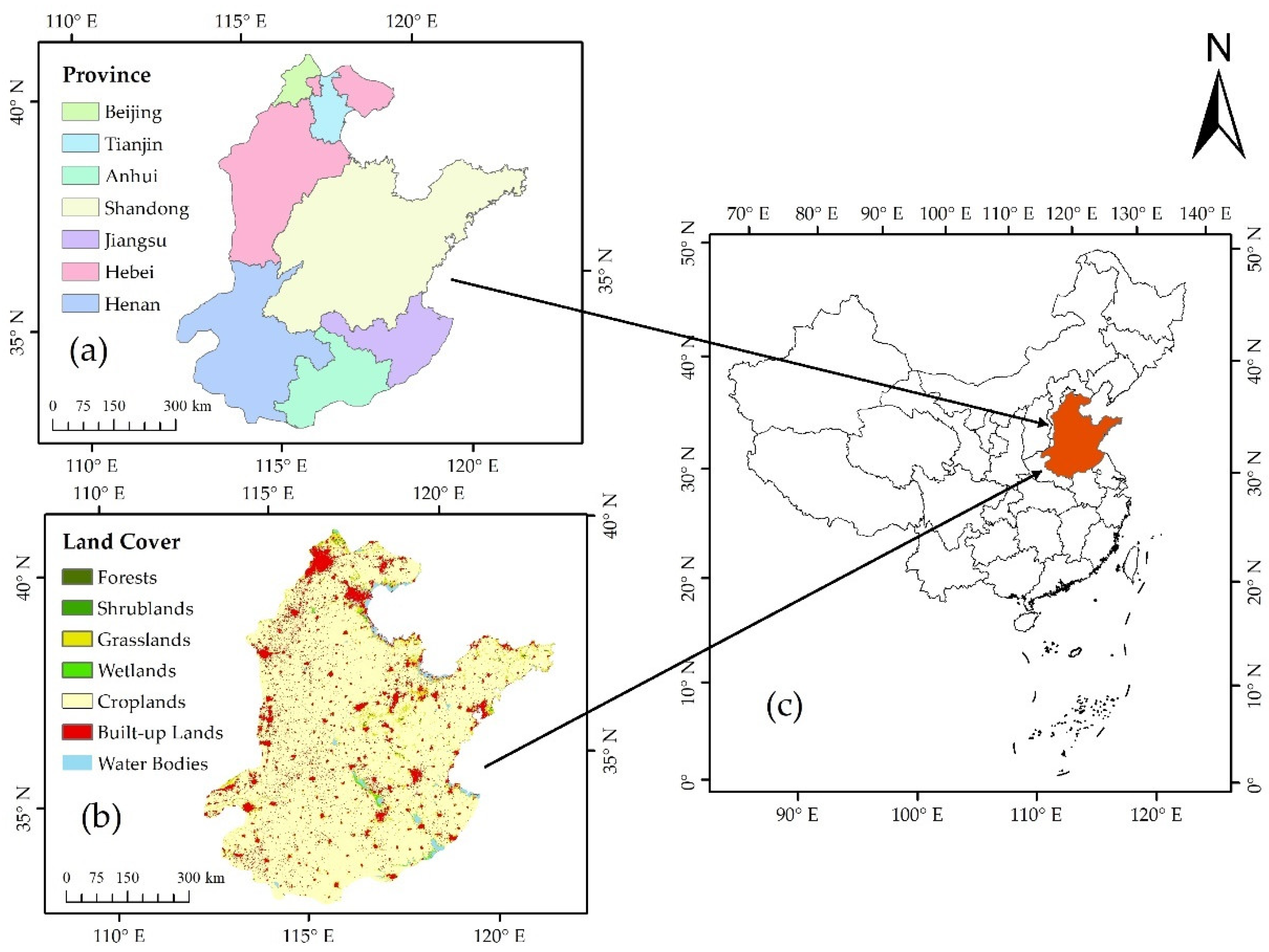
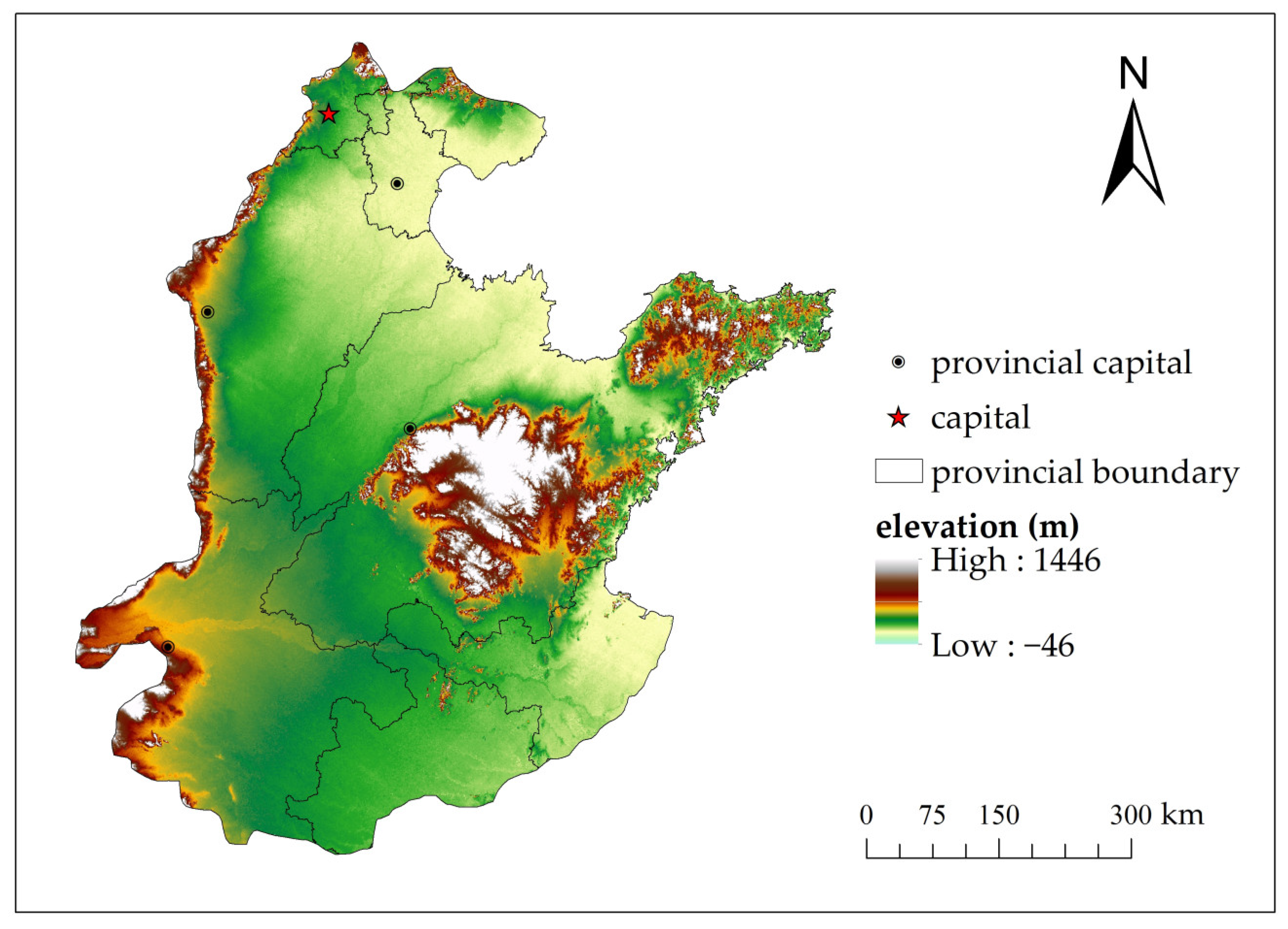
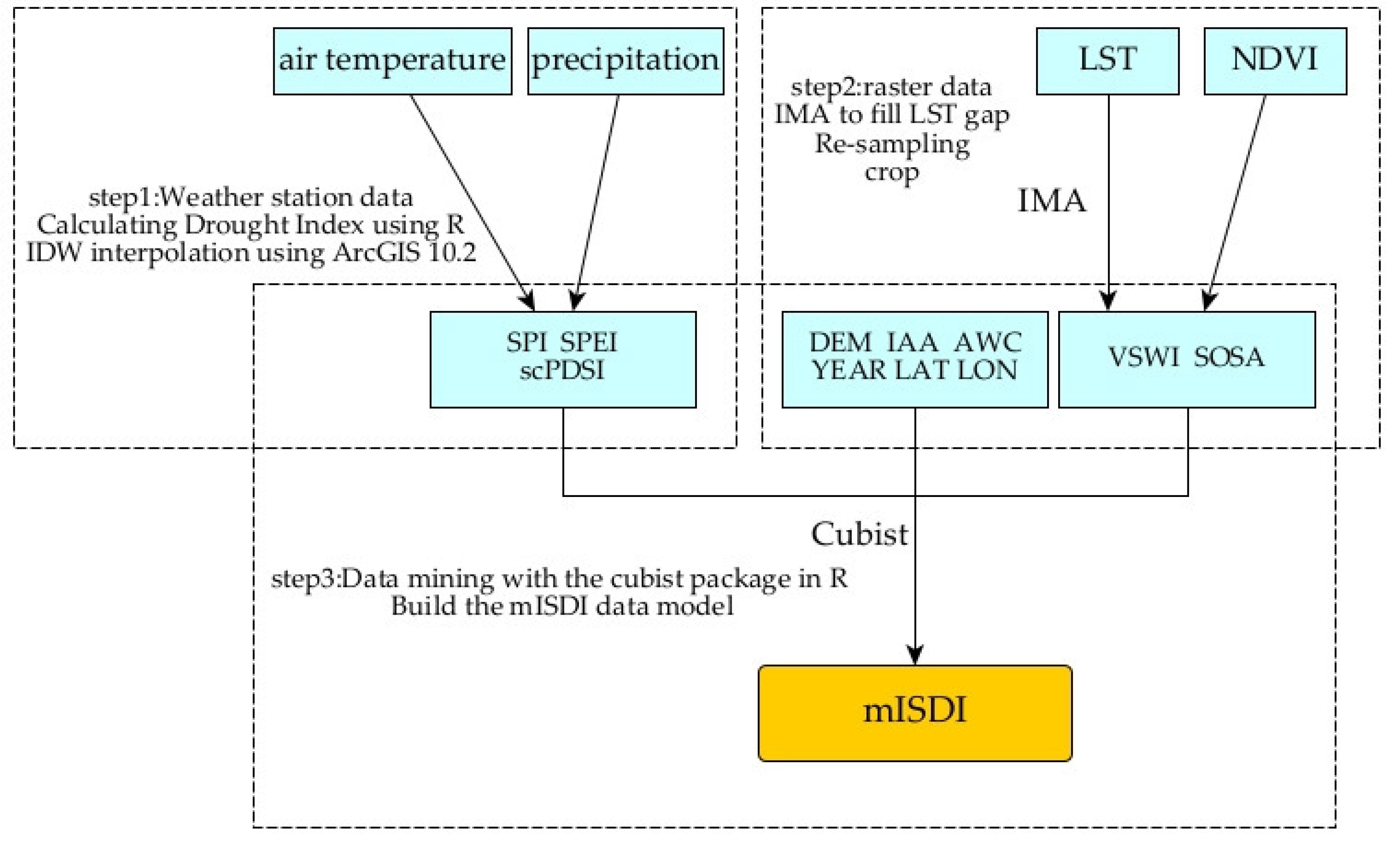

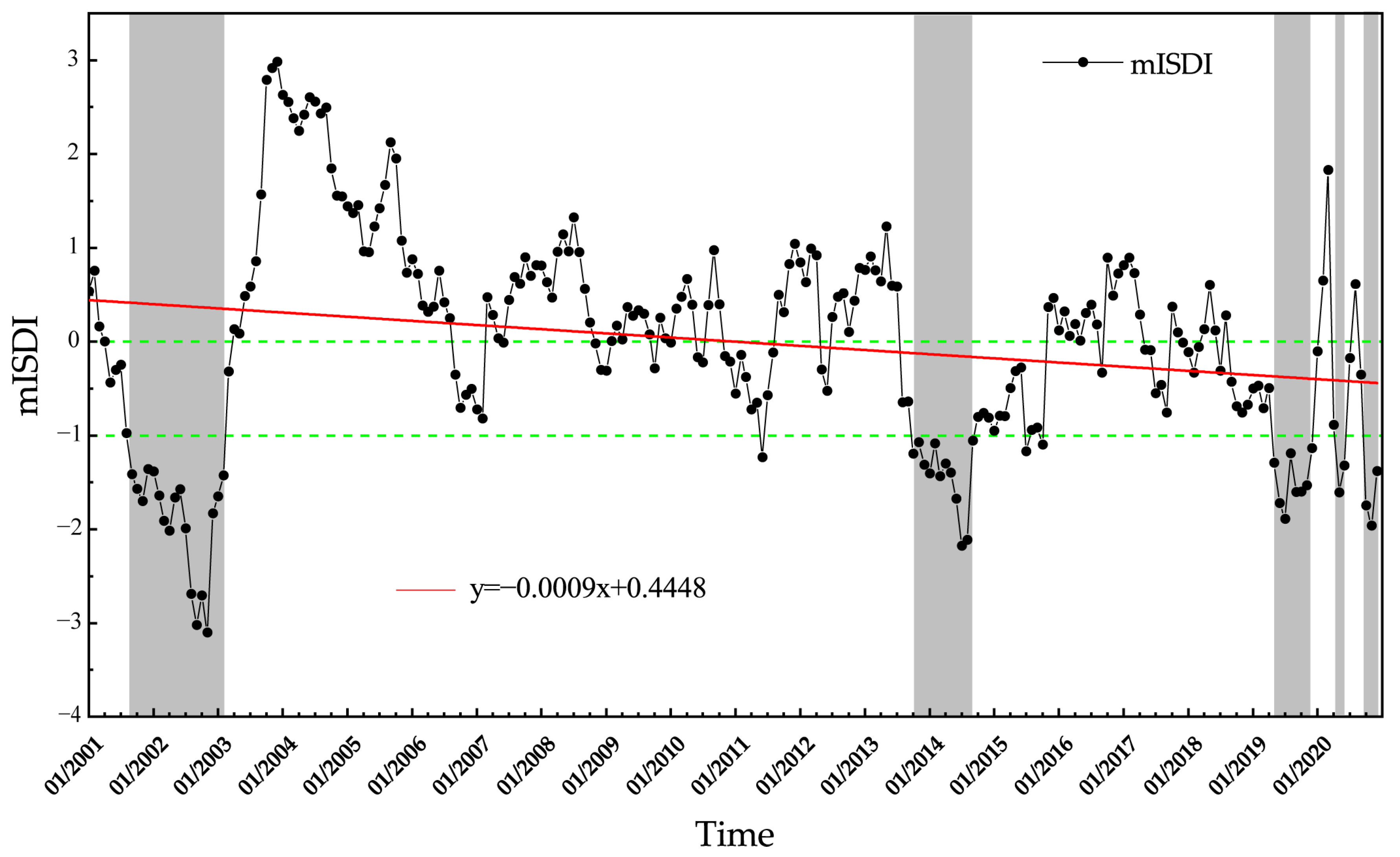


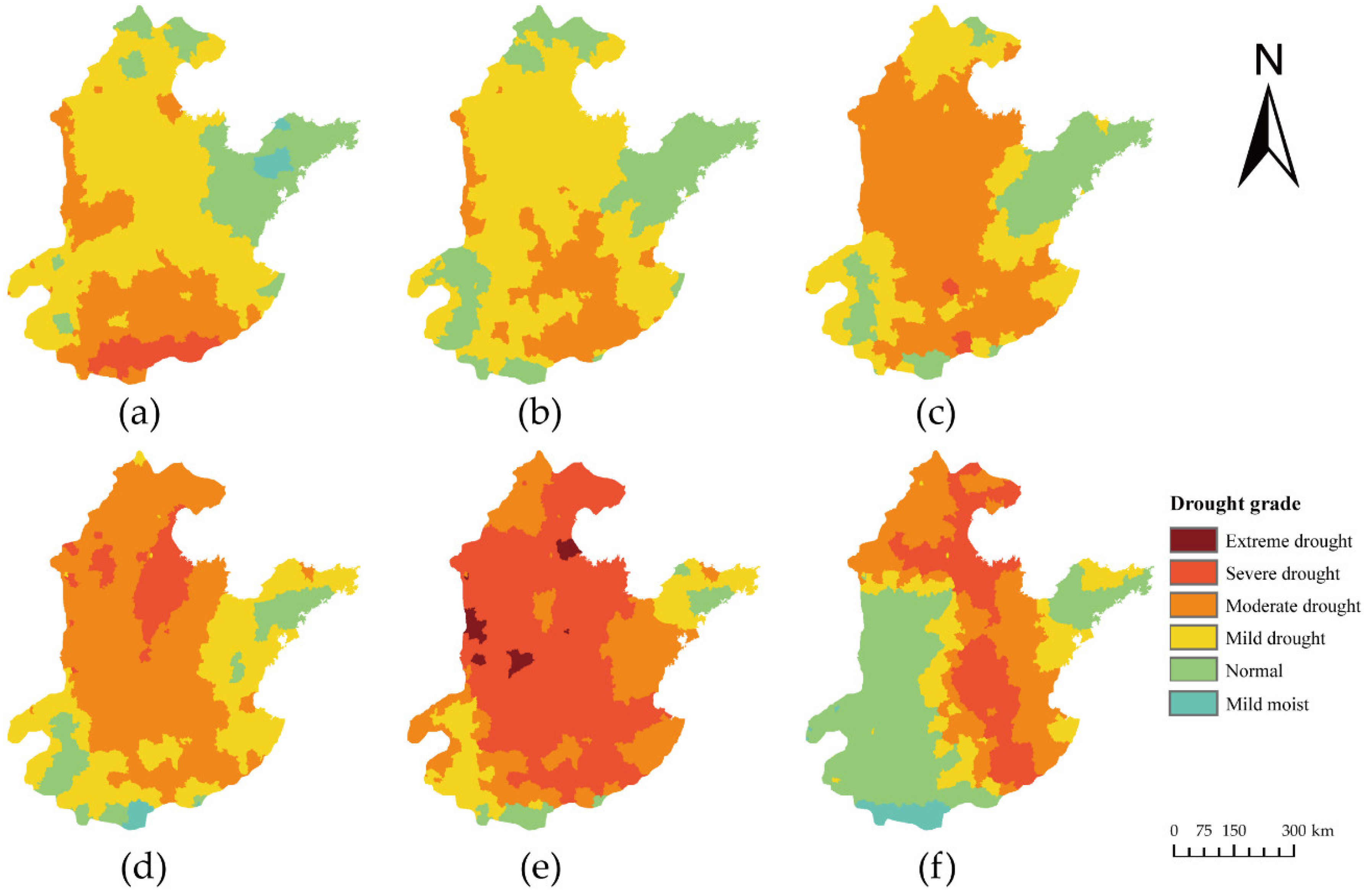

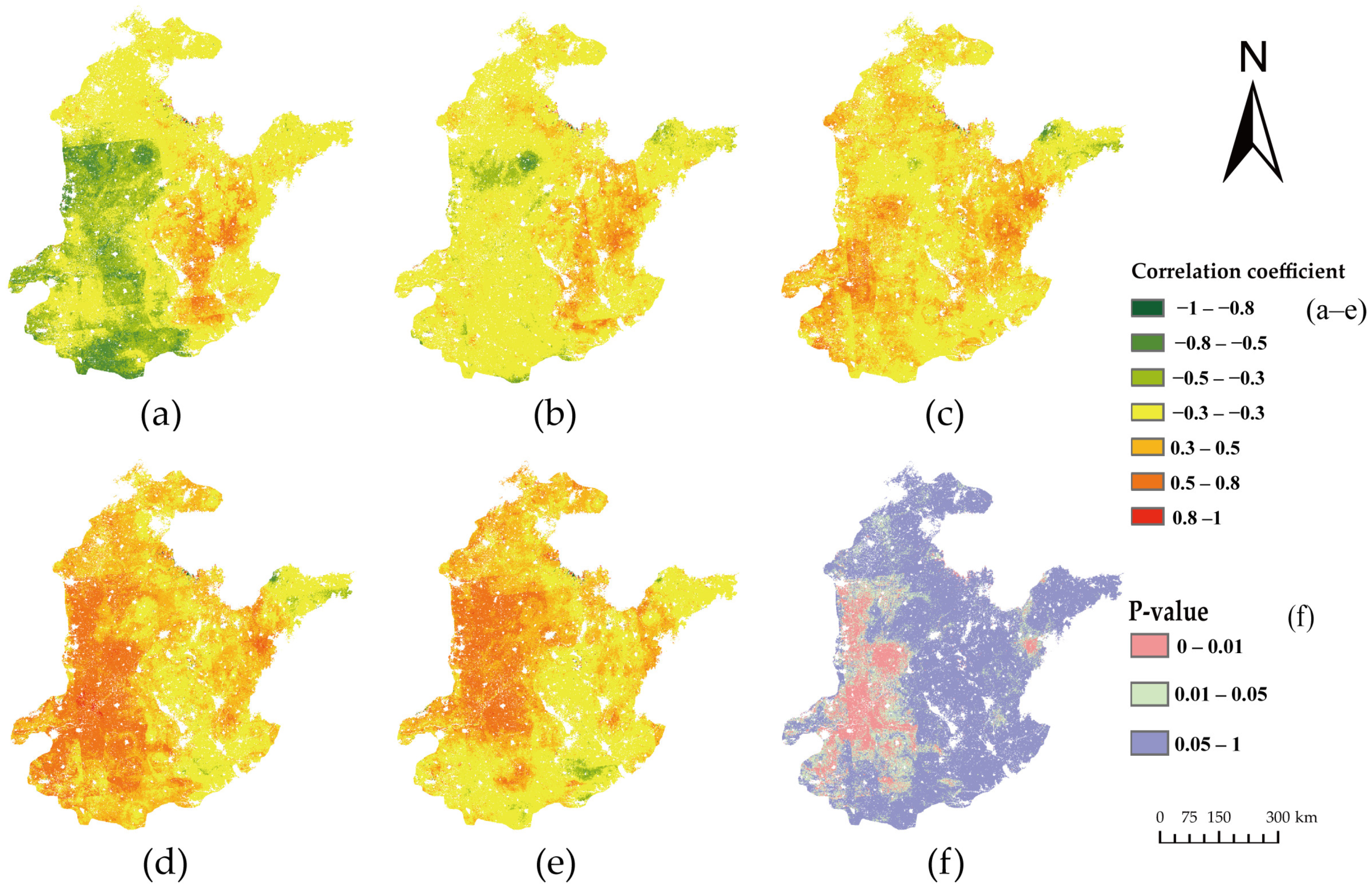
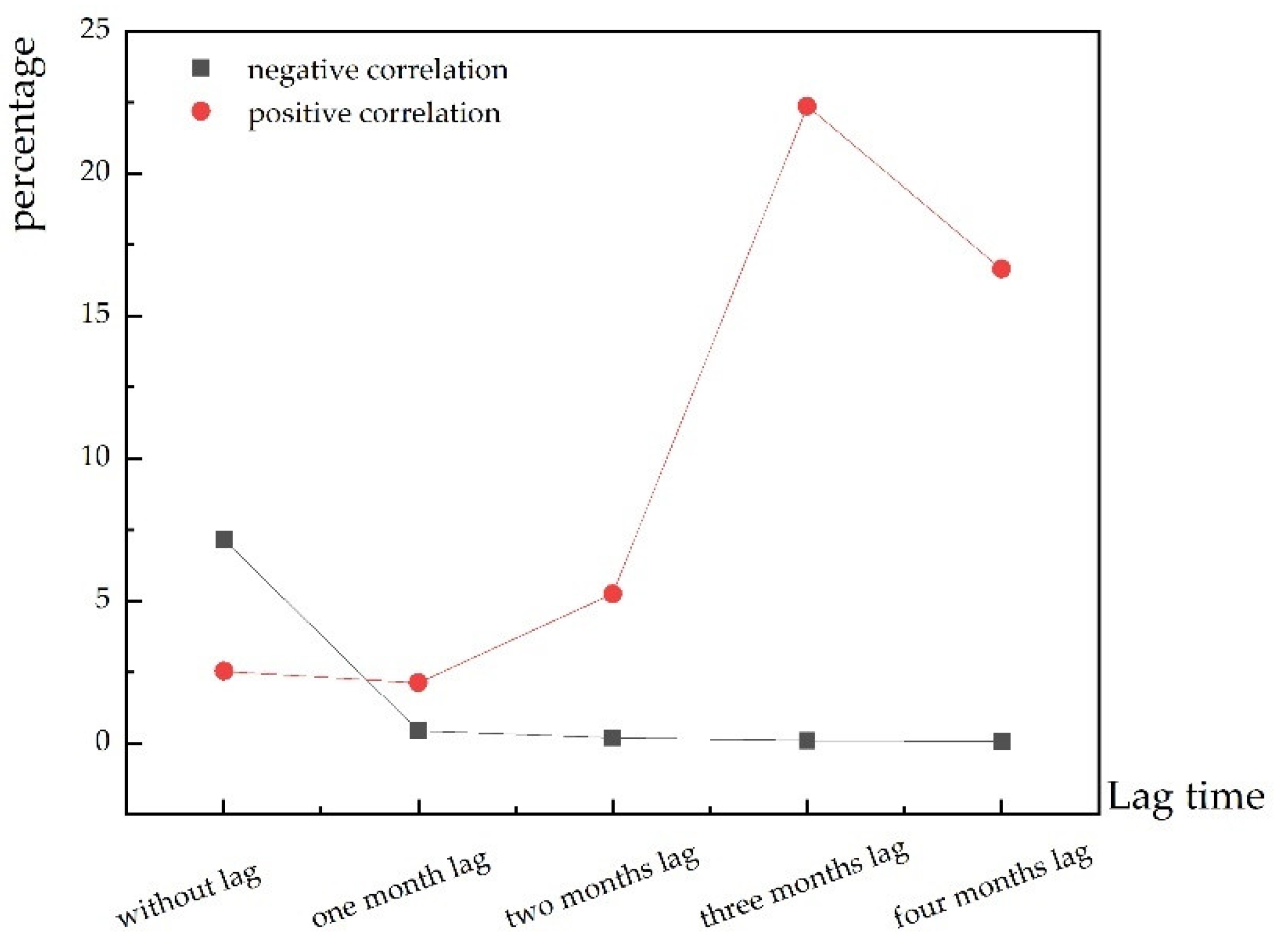
| Products | Date | Time Resolution | Amount of Data |
|---|---|---|---|
| MOD11A2 | 1 January 2001–31 December 2020 | 8 d | 918 |
| MOD13A3 | 1 January 2001–31 December 2020 | Month | 240 |
| MCD12Q1 | 1 January 2001–31 December 2019 | Year | 19 |
| MOD17A2HGF | 1 January 2001–31 December 2020 | 8 d | 920 |
| MOD16A2GF | 1 January 2001–31 December 2020 | 8 d | 920 |
| Name | Abbreviation | Resolution |
|---|---|---|
| land surface temperature | LST | 1 km |
| normalized difference vegetation index | NDVI | 1 km |
| gross primary production | GPP | 500 m |
| evapotranspiration | ET | 500 m |
| land cover | LC | 500 m |
| digital elevation model | DEM | 1 km |
| available water capacity | AWC | 1 km |
| Asian irrigated area map | IAA | 250 m |
| longitude and latitude | LON and LAT | 1 km |
| standardized precipitation index | SPI | stations |
| standardized precipitation evapotranspiration index | SPEI | stations |
| self-calibration palmer drought severity index | scPDSI | stations |
| palmer drought severity index | PDSI | stations |
| Index | Equation | Calculation | Time Resolution |
|---|---|---|---|
| SOSTi represents the start of the growing season in year n, and SOSTmed represents the median of the start of the growing season for the entire time series. SOST is calculated by TIMESAT based on the Savitzky–Golay filtered NDVI in the bear toolbox. | year | ||
| Pixel ratio of the NDVI to the LST per month | month |
| Combinations | Dependent Variable | Independent Variable |
|---|---|---|
| 1 | scPDSI | 1 SPI03, 2 SOSA, 3 VSWI, 4 AWC, 5 LC, 6 DEM, and 7 IAA |
| 2 | scPDSI | Add location variables (8 LAT and 9 LON) to combination 1 |
| 3 | scPDSI | Add time variables (10 YEAR) to combination 2 |
| 4 | scPDSI | SPEI, SOSA, VSWI, AWC, LC, and DEM IAA |
| 5 | scPDSI | Add location variables (LAT and LON) to combination 4 |
| 6 | scPDSI | Add time variables (YEAR) to combination 5 |
| mISDI Value | Drought Degree |
|---|---|
| mISDI ≥ 3 | severe moist |
| 2 ≤ mISDI < 3 | moderate moist |
| 0.5 ≤ mISDI < 2 | mild moist |
| −1 ≤ mISDI < 0.5 | normal |
| −2 ≤ mISDI < −1 | mild drought |
| −3 ≤ mISDI < −2 | moderate drought |
| −4 ≤ mISDI < −3 | severe drought |
| mISDI < −4 | extreme drought |
| 1 Combination | 2 MAE | 3 RMSE | 4 R2 |
|---|---|---|---|
| 1 | 1.057 | 1.384 | 0.619 |
| 2 | 0.725 | 0.980 | 0.819 |
| 3 | 0.156 | 0.253 | 0.987 |
| 4 | 1.069 | 1.387 | 0.618 |
| 5 | 0.712 | 0.959 | 0.827 |
| 6 | 0.162 | 0.265 | 0.986 |
| Drought Event | Duration | 1 DD | 2 DS | 3 DI |
|---|---|---|---|---|
| E1 | September 2001–February 2003 | 18 | 34.658 | −1.925 |
| E2 | October 2013–September 2014 | 12 | 17.230 | −1.436 |
| E3 | May 2019–December 2019 | 8 | 11.968 | −1.496 |
| E4 | May 2020–June 2020 | 2 | 2.931 | −1.466 |
| E5 | October 2020–December 2020 | 3 | 5.090 | −1.697 |
| 1 SCWUE | Z Value | Trend of the CWUE | Percentage |
|---|---|---|---|
| ≥0 | ≥1.96 | significant increase | 3.99% |
| ≥0 | −1.96–1.96 | insignificant increase | 60.78% |
| ≤0 | −1.96–1.96 | insignificant decrease | 35.17% |
| ≤0 | ≤1.96 | significant decrease | 0.06% |
Publisher’s Note: MDPI stays neutral with regard to jurisdictional claims in published maps and institutional affiliations. |
© 2022 by the authors. Licensee MDPI, Basel, Switzerland. This article is an open access article distributed under the terms and conditions of the Creative Commons Attribution (CC BY) license (https://creativecommons.org/licenses/by/4.0/).
Share and Cite
Wang, W.; Li, J.; Qu, H.; Xing, W.; Zhou, C.; Tu, Y.; He, Z. Spatial and Temporal Drought Characteristics in the Huanghuaihai Plain and Its Influence on Cropland Water Use Efficiency. Remote Sens. 2022, 14, 2381. https://doi.org/10.3390/rs14102381
Wang W, Li J, Qu H, Xing W, Zhou C, Tu Y, He Z. Spatial and Temporal Drought Characteristics in the Huanghuaihai Plain and Its Influence on Cropland Water Use Efficiency. Remote Sensing. 2022; 14(10):2381. https://doi.org/10.3390/rs14102381
Chicago/Turabian StyleWang, Weiyin, Junli Li, Hongjiao Qu, Wenwen Xing, Cheng Zhou, Youjun Tu, and Zongyi He. 2022. "Spatial and Temporal Drought Characteristics in the Huanghuaihai Plain and Its Influence on Cropland Water Use Efficiency" Remote Sensing 14, no. 10: 2381. https://doi.org/10.3390/rs14102381
APA StyleWang, W., Li, J., Qu, H., Xing, W., Zhou, C., Tu, Y., & He, Z. (2022). Spatial and Temporal Drought Characteristics in the Huanghuaihai Plain and Its Influence on Cropland Water Use Efficiency. Remote Sensing, 14(10), 2381. https://doi.org/10.3390/rs14102381






